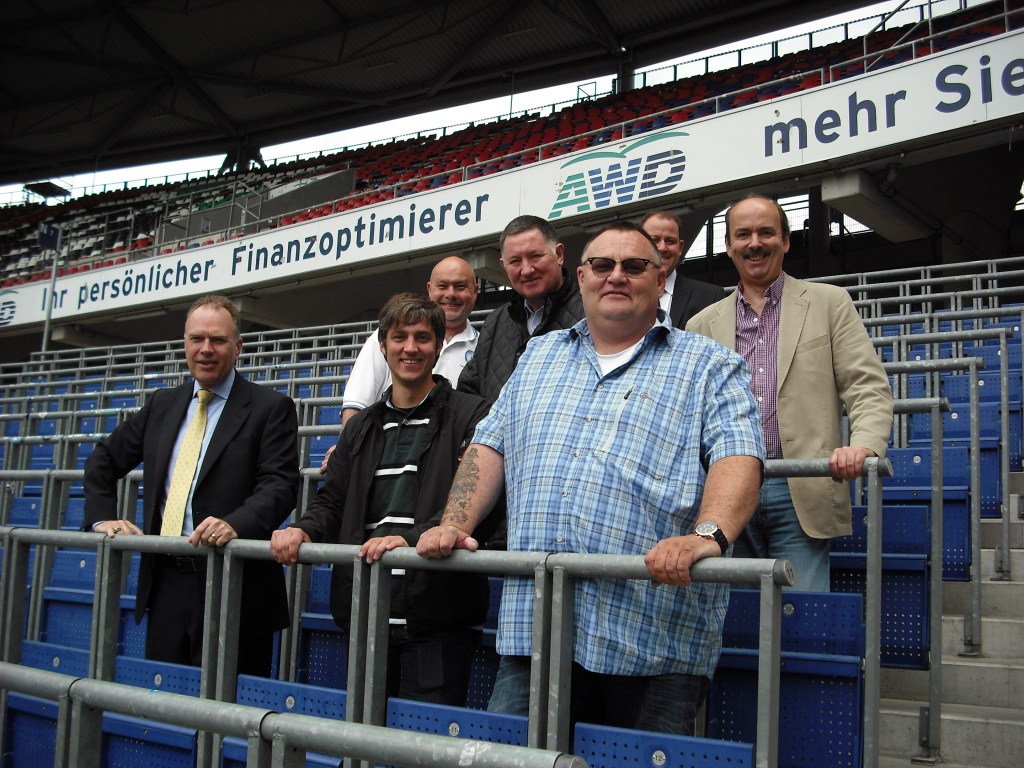By Danny Wyn Griffith
“Safe standing offers equality with fans of other sports,” says Jon Darch, a leading football safe standing campaigner, in an interview with Football Foyer.
“It will remove the illogical discrimination that says it’s safe to stand, for example, at rugby, but not at football. The ban never made any logical sense. It was always based on a discriminatory view of all football fans as hooligans that was rife in political circles in the 1980s. It was an ill-founded view then and is an anachronism now.
“Safe standing will also, of course, give all fans choice. For those who like to stand, it gives them a dedicated area in which to do so, configured in accordance with strict safety criteria. And for those who want to sit, or simply can’t stand for 90 minutes, it gives them the peace of mind of knowing that all the fans around them will be of a like mind and will also prefer to stay seated. Everyone wins!”
A former radio industry executive, Jon Darch (seen left in the main image) makes his living these days by translating German to English and acting as an agent for a manufacturer of stadium seats, whilst his connection to football has been deeply entrenched from a young age.
“I’ve been a supporter of Bristol City since 1967 and of Union Berlin since 2008,” he starts to explain. “I’ve also been a member of the Football Supporters Federation (now Association) for many years and a card-carrying member in absentia of Wrexham Supporters Trust, owners until any day now of Wrexham FC, having worked in Wrexham in the late eighties and developed a soft spot for the club.”
He recounts his first football memory as hearing on the radio that John Galley had scored a hat-trick on his debut for Bristol City at Huddersfield Town. That was back on 16 December 1967, whilst Jon was at a Bristol Grammar School event with his father. He recalls both being thrilled by their new centre-forward’s instant impact.
Jon is the face of the Safe Standing Roadshow campaign spearheading the push for it to be introduced at all levels in English football. His passion for safe standing can be traced right back to when he used to stand on the uncovered terrace at Ashton Gate.
“That goes back to those early days of going to football with my dad,” he says. “We used to stand on the ‘Open End’ at Ashton Gate (i.e., an uncovered terrace). He made a wooden stool for me to stand on so that I could see over the heads of the men in front.
“As a teenager, I then stood on the ‘East End’ with my mates. Twenty years later, when I was taking my nephews to games in what by then was an all-seater stadium, I thought it was a great shame that they couldn’t experience that same rite of passage. And I thought that the standing ban was illogical. And I hate things that are illogical!”
Good examples of safe standing can be seen on the continent, with German football being the prime example, whilst Celtic introduced their own safe standing section in 2016. In the higher-levels of the English pyramid, however, the story is different.
“The Thatcherite all-seater policy is still in force,” he says. “It stipulates that currently some 70-odd grounds must provide only seated accommodation. Since the end of 2018, clubs governed by the policy have been allowed to install “seats incorporating barriers” as a means of enhancing safety in areas where they have an issue with persistent standing, but they are not allowed to operate such areas as formal standing areas.
“The current Government won the last election on a manifesto that included a pledge to bring in safe standing. Had it not been for Covid, that would probably have happened by now. Hopefully, we won’t have to wait too much longer. In fact, what better way for Boris and co. to show their commitment to this than to say now that safe standing will be allowed from as soon as we can have capacity crowds again.
“The safety sector is persuaded of the fact that rail seats have a “positive impact on spectator safety” and have told the Government so. It now just needs the Government to amend the all-seater policy, or permit a more nuanced interpretation of it, for clubs to be allowed to operate formally approved safe standing areas in line with safety guidelines that are ready to be put in place.”
He hopes that as soon as fans are able to return to stadia at full capacity, clubs will be given the green light introduce safe standing. Better still, if they are told now that this will be the case, the clubs can plan ahead so that they are ready for the change.
“There is no team that doesn’t want it,” he states. “Many are actively making plans even now during the pandemic. Once the crowds are back and we’ve got the green light from Westminster, the vast majority will go ahead.
“Spurs have already installed seats incorporating barriers and Manchester United announced their intention last year to do the same. However, until the rules change, neither club is allowed to operate any area of their ground as safe standing. When the rules do change, the areas concerned will also need to be checked for compliance with any new safety regulations for standing areas that may come in.”
The situation at European competition level is slightly different. When clubs play in Europe there has to be a seat available for every fan. UEFA do not stipulate, however, that the fans must sit down.
Yet, are UEFA for or against the concept?
“Agnostic, I guess,” he starts to explain, “Rail seats were invented to satisfy their requirement that their matches be played in all-seater stadia. Rail seats do that, while enabling the areas concerned to be operated as standing areas for domestic games.
“UEFA – and FIFA too for that matter – have had no problem with this and regularly pick stadia with rail seats for some of their most prestigious games. Hamburg, Dortmund, Nuremberg, Hannover and Stuttgart, for example, were all World Cup 2006 venues and all of those grounds have rail seats.”
“Safe standing allows fans a choice,” he goes on to state. “And takes away the stain on our reputation placed there by a standing ban based on the false narrative created around the cause of Hillsborough.
“Five years from now, I would hope that by then there is no longer any such safe standing movement because it has become the accepted norm that all grounds provide a mix of seated and standing accommodation.”
Away from the safe standing campaign, Jon’s beloved Union Berlin are performing above expectation in the Bundesliga, currently placed eighth. Union gained promotion to the German top flight for the first time in the club’s history in time for the 2019–20 season.
“In short, Union’s forerunner club was founded in 1906,” he tells when asked about the history of the club.
“In its current guise, it was founded as the ‘civilian’ club in GDR East Berlin 1966; many years of unfair competition followed against the Stasi-backed other club in the east of the city (who won the league title ten years on the bounce). Then several financial crises happened post reunification, that were followed up with rescue acts by the fans; rebuilding of the stadium by the fans; rise from the 4th tier to the top flight; and next? “International”, perhaps!”
Last year saw the 100th anniversary of the club playing on the site of the current ground. The name of the stadium can be translated as ‘The Stadium next to the Old Forester’s Lodge’, and the ground is indeed on the edge of suburban woodlands, which mean that the walk to the stadium is along a muddy track through a tunnel of dark, overhanging trees.
Having previously visited the Stadion An der Alten Försterei back in 2018, I have some personal knowledge of the club, and the hard work that’s gone on behind the scenes to lift this club to the top-flight.
“Fans came to the rescue and around 2,000 individuals gave some 150,000 hours of free labour to help bring the stadium up to scratch.”
“Until 2009, the stadium was open terracing on three sides, with a puny little grandstand for about 2,000,” he describes. “Weeds were growing up through the terrace concrete, which in turn was crumbling. It was deemed inadequate for the second tier, let alone the Bundesliga.
“So, Union asked the fans – the members – what they wanted from a ‘modernised’ stadium. They said ‘standing’! So, plans were drawn up to tidy up the three terraces, give them a roof and, as phase two, to upgrade the main grandstand.”
Still there was a hitch. The club was once again short of cash. Therefore the fans came to the rescue and around 2,000 individuals gave some 150,000 hours of free labour to help bring the stadium up to scratch.
“Now we have a beautiful ground with three covered terraces and, since phase 2 was completed, a spanking new main stand. Capacity is 22,000-ish, 18,000-ish standing, and – pre-Covid – it was always sold out, so expansion is on the cards. A planning application has been submitted to expand to 37,000, with an upper tier above the three terraces. Again, largely standing. In all, in future it will be 8,000-ish seats and 28,500-ish standing – more even than at the Westfalenstadion!!”
Throughout Germany football fans are well known for achieving change in their domestic game, from kick-off times to the 50+1 rule. Might there be anything UK fans could learn from their equivalents on the continent?
“Organise, organise, organise!” he remarks. “The walk-out in protest against ticket prices on 77 minutes at Anfield a few years back organised by Spirit of Shankly and Spion Kop 1906 shows that fans do have power. But only if they organise themselves and work in unity. That’s what the German fans are so good at, and definitely what we can learn from them.
“Spouting off as a keyboard warrior is futile. Tens of thousands of fans voting with their feet in the real world, however, can move mountains!”
Find out more about Jon’s work with the Safe Standing Roadshow.



You must be logged in to post a comment.